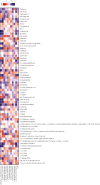Effects of Dietary Protein Level on the Microbial Composition and Metabolomic Profile in Postweaning Piglets
- PMID: 35401925
- PMCID: PMC8986435
- DOI: 10.1155/2022/3355687
Effects of Dietary Protein Level on the Microbial Composition and Metabolomic Profile in Postweaning Piglets
Abstract
Since the human and porcine digestive systems have similar anatomical structures and physiological functions, pigs are a useful animal model for studying human digestive diseases. By investigating intestinal metabolites in piglets after weaning, this study attempted to identify the inherent connection between dietary protein levels and changes in the intestinal microbiota of piglets. Casein was employed as the only source of protein for the piglets in this study to avoid the influence of other protein sources. 14 weaning at 28-day-old piglets (6.9 ± 0.19 kg) formed into two dietary groups: 17% casein fed group (LP) and 30% casein fed group (HP). Piglets were allowed to free food and water during the 2-week experiment. Throughout the trial, the piglets' diarrhea index (1: no diarrhea and 3: watery diarrhea) and food intake were noted during the experiment. We discovered piglets fed a high-protein diet developed diarrhea throughout the duration of the research, whereas piglets fed a normal protein diet did not. In addition, the HP group had lower feed intake and body weight than the control group (P < 0.05). The HP diet influenced the content of short-chain and branched-chain fatty acids in the colon, including acetate and isovaleric acid. The ileal microbiota's 16S rRNA gene was sequenced, and it was discovered that the relative abundance of gastrointestinal bacteria differed between the HP and control groups. Dietary protein levels influenced bile acid biosynthesis, alpha-linolenic acid metabolism, phospholipid biosynthesis, arachidonic acid metabolism, fatty acid biosynthesis, retinol metabolism, arginine and proline metabolism, pyrimidine metabolism, tryptophan metabolism, and glycine and serine metabolism, according to gas chromatography-mass spectrometry analysis. Furthermore, a correlation analysis of the pooled information revealed a possible link between intestinal metabolites and specific bacteria species. These findings demonstrate that weaned piglets' microbiota composition and metabolites are modified by a high-protein diet and thus inducing severe postweaning diarrhea and inhibiting growth performance. However, the potential molecular mechanism of this regulation in the growth of piglets remains unclear.
Copyright © 2022 Jing Gao et al.
Conflict of interest statement
There are no conflicts of interest stated by the authors.
Figures





References
Publication types
MeSH terms
Substances
LinkOut - more resources
Full Text Sources
Research Materials
Miscellaneous

